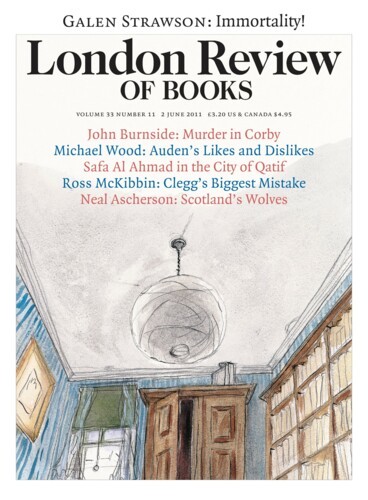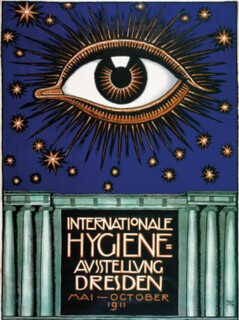On Fridays the binmen collect orange plastic bags of recyclables and black bags of corruptibles. I have a particular image of what things would be like if they never came. Some decades ago friends wanted to buy a house in East Finchley. They had to track down an owner too ashamed of the state his house was in to put the place on the market. By the time I saw it skiploads of rubbish had been taken away, but there was still a mass of indeterminate material underfoot, even a fireplace stacked with used sanitary towels. One imagined a domestic breakdown: ‘You do it.’ ‘No, you do it.’
So for me the words ‘East Finchley’ call up an image of the dirt and disorder that wait on social failure at any scale from the domestic to the national. The waiting bags of rubbish in our street – or news pictures of Naples or London when refuse collectors go on strike – are enough to bring its look and smell to mind. Here, today, the failure of sanitation and its associated diseases are a cloud on a distant and indeterminate horizon. But what was once the reality here, and is now a reality in the slums of Mumbai, is at worst something to put alongside climate change and the pathologies of the collapsed civilisations Jared Diamond writes about. Dirt: The Filthy Reality of Everyday Life at the Wellcome Collection (until 31 August), which works on the instincts that make filth disgusting and cleanliness desirable, is not a comfortable exhibition.
The desire to keep self and environment proper goes deep. In the book of the exhibition one reads that primates spend up to 20 per cent of their time at the mutual grooming that creates social bonds, controls parasites and straightens tangles.* Birds preen, cats and dogs lick themselves. In Dirt, 17th-century Dutch paintings and engravings of women combing hair and chasing lice, scouring and sweeping, celebrate the processes that keep things clean. The images are reasonably respectful of the people who do it, but the nastiest jobs, like emptying cesspits, too often get dumped on another class or caste that is then defined as unclean. There is an engraving of prostitutes in Switzerland, punished by being harnessed to the scavengers’ cart. Riches and opportunities made cities attractive; the accumulation of refuse and excrement could make them stinking death traps. That dirt and poverty went with disease was clear. Just what caused disease was not.
The exhibition begins with things too small to be resolved by the naked eye. A modern image next to one of van Leeuwenhoek’s astonishingly simple microscopes – no more than a little metal bracket with screws to adjust the position of a specimen held on a pin in front of its single lens – gives some idea of what (aided by remarkable eyesight) van Leeuwenhoek saw through his bead of glass. It was several centuries before the animalcules he drew were identified as causes of disease. Bad smells and visible grime were easier to point to. Long after John Snow’s demonstration that something waterborne would explain the distribution of cholera cases in the area served by the Broad Street pump (his plan of the area, mapping mortality, is on display) the theory that it was a miasma – infected air – that transmitted diseases still flourished.
And the nose, which finds the smell of faeces uniquely unpleasant, was, up to a point, the organ to follow. Although smell was irrelevant to the crucial link between cholera and the water supply, it didn’t require microscopy to persuade people to create sewers or to take action when the smell of the Thames became intolerable. There is evidence here of the efforts of public authorities to make cities less noisome and less fatal, among them a 17th-century document dealing with scavengers responsible for cleaning London streets, and plans and pictures of the interceptor sewers, 82 miles of them, constructed by Sir Joseph Bazalgette in the 1860s to redirect London’s effluent well downstream to Crossness.
One main strand in Dirt deals with the evils of uncleanliness, spiritual as well as physical. Another addresses the practicalities and aesthetics of the healthy, germ-free life. There is a wall of 17th-century Delft tiles: like floor tiles, they provided a surface that could be cleaned; the interiors in the paintings here by de Hooch are short on drapery, long on hard surfaces that could be dusted, scrubbed and polished. In the 20th century, in part as a reaction against the housemaid’s nightmare, a fully knick-knacked and draped 19th-century-drawing room, modernism arrived. White and nook-free architecture left no hiding place for dirt. The architects of the Finsbury Health Centre of 1938 (Berthold Lubetkin and Tecton) made much of the clean lines of their building (going so far as to point to the gaps in traditional tiled roofs as sources of dirt and infection). The building still stands, though it has been threatened with what enthusiasts for its status as a functioning icon of early modernism claim is a destructive refurbishment.
The first International Hygiene exhibition, visited by many thousands, was held in Dresden in 1911. The second, in 1930, took place in the halls of what became the German Hygiene Museum. The architecture of the interior of the main block is disturbingly totalitarian. In Dirt, a wall of Nazi propaganda linking Jews, dirt and disease is one example of the use of ‘dirty’ as a label for anything you dislike (or sometimes envy), and of ‘cleanse’ to justify what you do to destroy it. Elizabeth Pisani’s particularly lively essay, ‘Leviticus Be Damned’, deals with ritual cleansing, and the whole array of what is, in one context or another, reckoned to be unclean – from lobsters, menstruation and the filthy rich to sex and dirty art. Perhaps the most famous example of this last is Piero Manzoni’s 1961 edition of cans of his own shit, one of which made €120,000 at Sotheby’s in 2007. For Laid to Rest, an artwork made specifically for this show, Serena Korda fired bricks which incorporate dust from houses, businesses and institutions: the piece looks back to the use by brickmakers of cinders from London’s Victorian dust heaps. Another artwork is Bruce Nauman’s Raw Material Washing Hands, a video loop showing hands under running water. It is a measure of the effectiveness of Dirt that it leaves you, too, wanting to find a tap.
Happily, at the end of the exhibition you are offered something that can lighten the guilt brought on by thoughts of how we have transformed the resources of the earth into oceanic rafts of floating plastic rubbish and toxic mounds of discarded electronics. The final space deals with the history of Fresh Kills, a landfill site covering what was an area of salt marsh on the west shore of Staten Island. It began to be filled with New York garbage in 1948. When legislation was passed in 1995 announcing that it would be closed in 2001, it spanned nearly 2200 acres – about two and a half times the size of Central Park. Its life as a dump was extended following the destruction of the World Trade Center, when detritus was sorted and searched there, but it is now on the way to becoming parkland, walking tracks and sports fields. It means of course that New York’s garbage has to be transported elsewhere, but the idea that we can sometimes bury our sins is a comfort, albeit a small one: Staten Island is a world away from the middens on the outskirts of slums in the world’s burgeoning Third World cities.
Send Letters To:
The Editor
London Review of Books,
28 Little Russell Street
London, WC1A 2HN
letters@lrb.co.uk
Please include name, address, and a telephone number.


